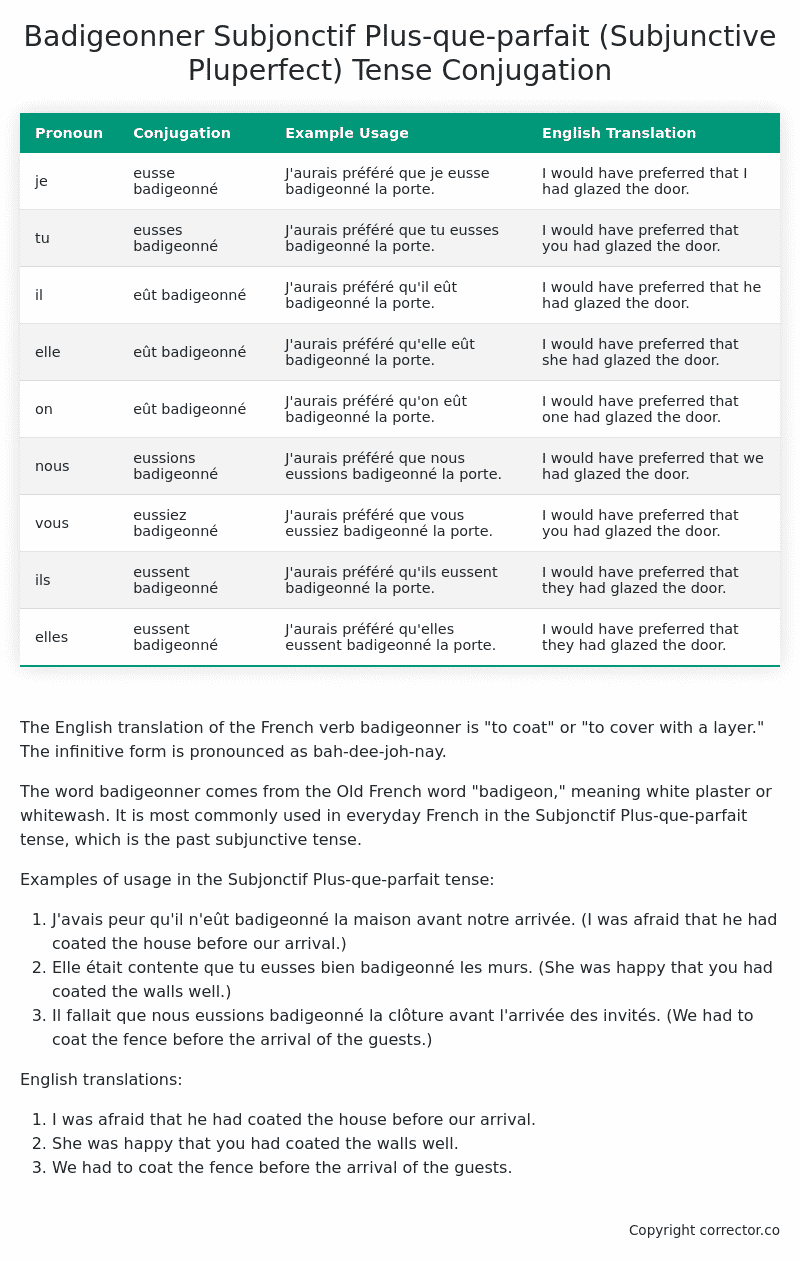Subjonctif Plus-que-parfait (Subjunctive Pluperfect) Tense Conjugation of the French Verb badigeonner
Introduction to the verb badigeonner
The English translation of the French verb badigeonner is “to coat” or “to cover with a layer.” The infinitive form is pronounced as bah-dee-joh-nay.
The word badigeonner comes from the Old French word “badigeon,” meaning white plaster or whitewash. It is most commonly used in everyday French in the Subjonctif Plus-que-parfait tense, which is the past subjunctive tense.
Examples of usage in the Subjonctif Plus-que-parfait tense:
- J’avais peur qu’il n’eût badigeonné la maison avant notre arrivée. (I was afraid that he had coated the house before our arrival.)
- Elle était contente que tu eusses bien badigeonné les murs. (She was happy that you had coated the walls well.)
- Il fallait que nous eussions badigeonné la clôture avant l’arrivée des invités. (We had to coat the fence before the arrival of the guests.)
English translations:
- I was afraid that he had coated the house before our arrival.
- She was happy that you had coated the walls well.
- We had to coat the fence before the arrival of the guests.
Table of the Subjonctif Plus-que-parfait (Subjunctive Pluperfect) Tense Conjugation of badigeonner
| Pronoun | Conjugation | Example Usage | English Translation |
|---|---|---|---|
| je | eusse badigeonné | J’aurais préféré que je eusse badigeonné la porte. | I would have preferred that I had glazed the door. |
| tu | eusses badigeonné | J’aurais préféré que tu eusses badigeonné la porte. | I would have preferred that you had glazed the door. |
| il | eût badigeonné | J’aurais préféré qu’il eût badigeonné la porte. | I would have preferred that he had glazed the door. |
| elle | eût badigeonné | J’aurais préféré qu’elle eût badigeonné la porte. | I would have preferred that she had glazed the door. |
| on | eût badigeonné | J’aurais préféré qu’on eût badigeonné la porte. | I would have preferred that one had glazed the door. |
| nous | eussions badigeonné | J’aurais préféré que nous eussions badigeonné la porte. | I would have preferred that we had glazed the door. |
| vous | eussiez badigeonné | J’aurais préféré que vous eussiez badigeonné la porte. | I would have preferred that you had glazed the door. |
| ils | eussent badigeonné | J’aurais préféré qu’ils eussent badigeonné la porte. | I would have preferred that they had glazed the door. |
| elles | eussent badigeonné | J’aurais préféré qu’elles eussent badigeonné la porte. | I would have preferred that they had glazed the door. |
Other Conjugations for Badigeonner.
Le Present (Present Tense) Conjugation of the French Verb badigeonner
Imparfait (Imperfect) Tense Conjugation of the French Verb badigeonner
Passé Simple (Simple Past) Tense Conjugation of the French Verb badigeonner
Passé Composé (Present Perfect) Tense Conjugation of the French Verb badigeonner
Futur Simple (Simple Future) Tense Conjugation of the French Verb badigeonner
Futur Proche (Near Future) Tense Conjugation of the French Verb badigeonner
Plus-que-parfait (Pluperfect) Tense Conjugation of the French Verb badigeonner
Passé Antérieur (Past Anterior) Tense Conjugation of the French Verb badigeonner
Futur Antérieur (Future Anterior) Tense Conjugation of the French Verb badigeonner
Subjonctif Présent (Subjunctive Present) Tense Conjugation of the French Verb badigeonner
Subjonctif Passé (Subjunctive Past) Tense Conjugation of the French Verb badigeonner
Subjonctif Imparfait (Subjunctive Imperfect) Tense Conjugation of the French Verb badigeonner
Conditionnel Présent (Conditional Present) Tense Conjugation of the French Verb badigeonner
Conditionnel Passé (Conditional Past) Tense Conjugation of the French Verb badigeonner
L’impératif Présent (Imperative Present) Tense Conjugation of the French Verb badigeonner
L’infinitif Présent (Infinitive Present) Tense Conjugation of the French Verb badigeonner
(this article)
Struggling with French verbs or the language in general? Why not use our free French Grammar Checker – no registration required!
Get a FREE Download Study Sheet of this Conjugation 🔥
Simply right click the image below, click “save image” and get your free reference for the badigeonner Subjonctif Plus-que-parfait tense conjugation!

Badigeonner – About the French Subjonctif Plus-que-parfait (Subjunctive Pluperfect) Tense
Formation
Common Everyday Usage Patterns
Hypothetical Situations
Reported Speech
Doubt, Wishes, and Emotions
Interactions with Other Tenses
Present Subjunctive
Imperfect Subjunctive
Conditional
Summary
I hope you enjoyed this article on the verb badigeonner. Still in a learning mood? Check out another TOTALLY random French verb conjugation!


